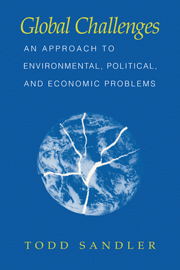Book contents
- Frontmatter
- Contents
- List of tables and figures
- Preface
- Acknowledgments
- 1 Apocalypse now or never?
- 2 Global interdependencies: Basic tools and principles
- 3 For our children's children
- 4 Global house
- 5 Architecture of institutions
- 6 Change we must: Evolutionary concerns
- 7 Equity among nations?
- 8 Near horizons
- References
- Author index
- Subject index
5 - Architecture of institutions
Published online by Cambridge University Press: 05 June 2012
- Frontmatter
- Contents
- List of tables and figures
- Preface
- Acknowledgments
- 1 Apocalypse now or never?
- 2 Global interdependencies: Basic tools and principles
- 3 For our children's children
- 4 Global house
- 5 Architecture of institutions
- 6 Change we must: Evolutionary concerns
- 7 Equity among nations?
- 8 Near horizons
- References
- Author index
- Subject index
Summary
Some global contingencies may require nations to consider institutional initiatives and forms of governances that extend beyond the traditional nation-state. In select cases, current global challenges could eventually result in institutional changes greater than any experienced since the creation of the nation-state. The nation-state ushered in an era of nationalism in which a sense of citizenship flourished. In contrast, the establishment of supranational linkages could promote a blurring of nationalism in which an identity of world inhabitant takes root. In Chapter 4, I argued that not all global challenges require federations or explicit linkages, where nations sacrifice their authority to a higher supranational authority. Many challenges possess the appropriate incentives to motivate nations to bargain among themselves or else to form loose ad hoc agreements without the need for elaborative structures. Although the world is besieged by transnational problems, there is as yet no need for a world government where nationalism is cast aside. Given general trends for the breakup of nations, it is naive to expect a reversal in which smaller nations combine into larger units. The sole exception to this trend – the European Union (EU) – remains far from being a single nation-state. Even more unrealistic is the possibility that nations will join a single world federation that oversees their affairs. The nation-state will remain an important player in world affairs for the foreseeable future.
- Type
- Chapter
- Information
- Global ChallengesAn Approach to Environmental, Political, and Economic Problems, pp. 142 - 164Publisher: Cambridge University PressPrint publication year: 1997



